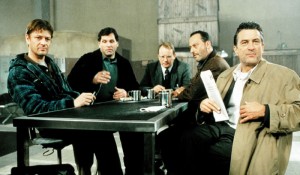Week 10 brought with it the screening of Ronin (1998, d. John Frankenheimer), and the questions
- What is action cinema?
- Is it just mindless entertainment?
- What can it do?
Action cinema traditionally follows the story of a resourceful protagonist up against a life-threatening challenge or situation. It takes on a fast pace and normally includes violence, close combat or physical feats to entertain it’s viewers. But can these films have deeper meaning? I believe the answer is yes, especially with those based around a strong narrative plot. Films like Ocean Eleven(2001, Steven Soderbergh) and Ronin have an involved narrative structure and if you aren’t following along you will quickly lose track of what is going on: especially if there is an ensemble cast like in these films. Of course, there are still plenty if chase scenes and action-packed sequences, but these are made even better with a hint of mystery and trepidation.
Lisa Purse writes in the third chapter of her book Contemporary Action Cinema, that the action sequence is perceived by scholars as a crucial ingredient in the blockbuster format. She writes that most action films seek to put the viewer within these sequences so they can experience them both ‘with the protagonists and for ourselves’. With the spatial co-ordinates and movement fleshed out, the viewer is even more entertained. This is what a good action sequence is all about: making the audience feel like they are there. I felt like Ronan did this at times, but was more focused on the narrative then straight up ‘mindless entertainment’ like Fast & Furious 4(2009, Justin Lin) which was the film Lisa Purse looked at.
Along with discussing the action genre, the class worked on our final assessment: either a number of short genre sketches or one long one. As I have mentioned, me and Brydan have been working on an 8-10 minute bottle film with hints of the vampire and western genre. We have just completed our script and shot list, and are currently in the process of locking down actors and a location. We also need to do more research for our exegeses’ which will be based on our video and it’s creation.
Below I have attached a link for our script, which may take on minor changes as our research continues.
Dinner For Three: Draft Script
References:
- Purse, Lisa (2011). Chapter 3: The action sequence. In Contemporary action cinema. Edinburgh: Edinburgh University Press, pp. 56-75.

Leave a Reply